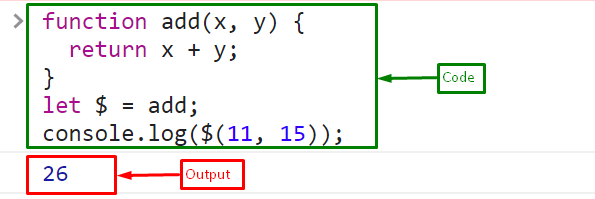What is the Meaning of “$” Sign in JavaScript
This post will discuss the meaning of the “$” sign and its usage in JavaScript.
What is the Meaning of the “$” Sign in JavaScript?
The “$” sign is not a special character in JavaScript and doesn’t have a special meaning or function. However, in JavaScript, it can be utilized as:
Method 1: How to Use the “$” Sign as an Identifier?
In JavaScript, an identifier is a name used to identify a variable, function, or property. The first character of an identifier must be a letter, a dollar sign ($), or an underscore (_), and any following characters may also be digits (0-9). Although JavaScript treats “$” as an alphabetic character, that’s why it can also be used as a variable name in JavaScript.
Example
Create a variable that acts as an identifier:
Pass the identifier to the console.log() method that will identify the stored value in a variable:
Output

Method 2: How to Use the “$” Sign as a Shortcut of Function?
The “$” sign can be used as a shortcut for a function in JavaScript by assigning a function to the $ variable or using the $ sign as a function name.
Here’s an example of how you can use the $ sign as a shortcut for a function.
Example
Define a function for adding numbers named “add”:
return x + y;
}
Assign the add() function to a “$” variable, which means that the “$” variable is now a reference to the add function:
Call the add() function using “$()” by passing values:
Output

You can also use the “$” sign as the function name itself.
return x + y;
}
Output

Note that using the $ sign as a function name or a variable name is not a good practice because it can be confusing and may cause conflicts with other libraries or code that use the $ sign in a different way.
Method 3: How to Use the “$” Sign in Template Literals?
In JavaScript, the “$” sign can embed expressions in template literals. Template literals are strings surrounded by backticks (`) instead of single or double quotation marks. They allow you to embed expressions inside the string using placeholders in the form of “${expression}”.
Example
Create two variables “x” and “y” with values “5” and “11”, respectively:
var y = 11;
Store the product of x and y in variable “z”:
Print the result using template literals:
Output

That’s all about the usage of “$” sign in JavaScript.
Conclusion
The “$” sign is not a special character in JavaScript. Still, it can be used as a variable name, identifier, function shortcut, or in template literals to embed the result with a string in the form of an expression. However, using the “$” sign as a function or variable name is not a good practice, but using it as a template literal is very helpful. This post described the meaning of the “$” sign and the methods to utilize it in JavaScript.
Source: linuxhint.com
